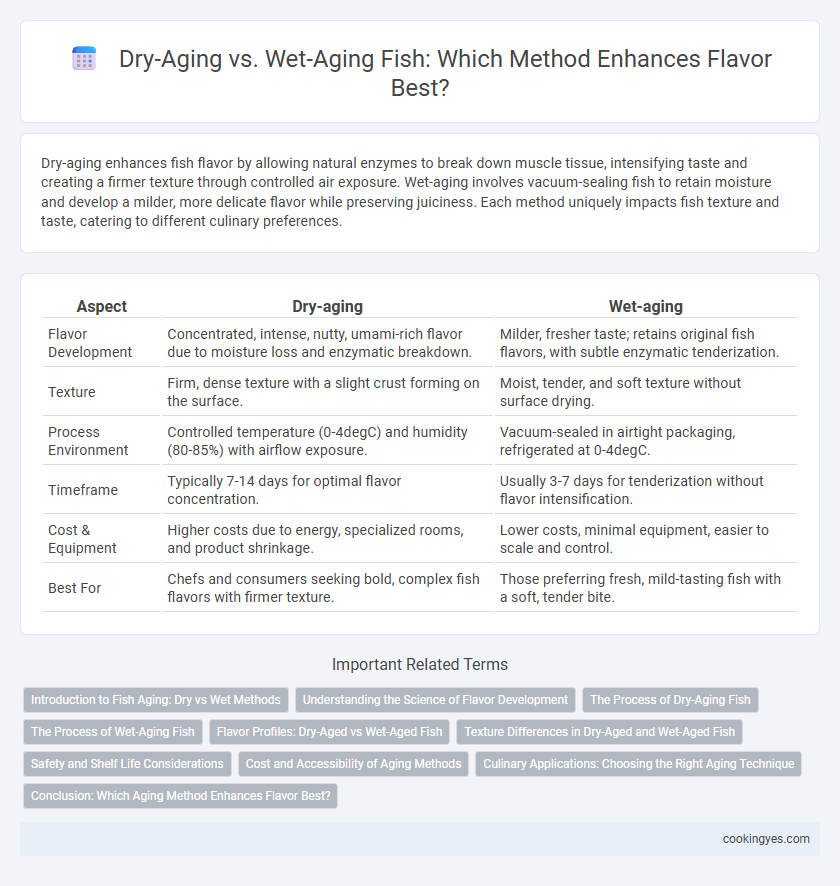Dry-aging enhances fish flavor by allowing natural enzymes to break down muscle tissue, intensifying taste and creating a firmer texture through controlled air exposure. Wet-aging involves vacuum-sealing fish to retain moisture and develop a milder, more delicate flavor while preserving juiciness. Each method uniquely impacts fish texture and taste, catering to different culinary preferences.
Table of Comparison
| Aspect | Dry-aging | Wet-aging |
|---|---|---|
| Flavor Development | Concentrated, intense, nutty, umami-rich flavor due to moisture loss and enzymatic breakdown. | Milder, fresher taste; retains original fish flavors, with subtle enzymatic tenderization. |
| Texture | Firm, dense texture with a slight crust forming on the surface. | Moist, tender, and soft texture without surface drying. |
| Process Environment | Controlled temperature (0-4degC) and humidity (80-85%) with airflow exposure. | Vacuum-sealed in airtight packaging, refrigerated at 0-4degC. |
| Timeframe | Typically 7-14 days for optimal flavor concentration. | Usually 3-7 days for tenderization without flavor intensification. |
| Cost & Equipment | Higher costs due to energy, specialized rooms, and product shrinkage. | Lower costs, minimal equipment, easier to scale and control. |
| Best For | Chefs and consumers seeking bold, complex fish flavors with firmer texture. | Those preferring fresh, mild-tasting fish with a soft, tender bite. |
Introduction to Fish Aging: Dry vs Wet Methods
Dry-aging fish enhances flavor by allowing enzymatic and biochemical processes to intensify taste through slow moisture evaporation, resulting in a firmer texture and concentrated umami notes. Wet-aging involves vacuum-sealing fish to retain moisture while natural enzymes break down muscle tissues, producing a more delicate and subtle flavor profile. Both methods influence the texture, aroma, and overall taste, with dry-aging favored for richer complexity and wet-aging for freshness and tenderness.
Understanding the Science of Flavor Development
Dry-aging intensifies flavor in fish by allowing natural enzymes and bacteria to break down muscle tissue, creating a more concentrated, umami-rich taste with a firmer texture. Wet-aging, conducted in vacuum-sealed packaging, preserves moisture and promotes enzymatic breakdown without exposure to air, resulting in a milder, buttery flavor with enhanced tenderness. The choice between dry-aging and wet-aging depends on desired flavor profiles and texture, with dry-aging producing robust, complex notes and wet-aging offering subtle, delicate flavors.
The Process of Dry-Aging Fish
Dry-aging fish involves storing whole fish or fillets in a controlled environment with precise temperature and humidity levels, typically between 32degF and 39degF and 75-85% humidity, to enhance flavor and texture. This process encourages enzymatic breakdown and moisture evaporation, concentrating flavors and tenderizing the flesh over several days to weeks. Proper air circulation and protection from contamination are critical to prevent spoilage while developing the fish's unique umami profile.
The Process of Wet-Aging Fish
Wet-aging fish involves vacuum-sealing fresh fillets to retain moisture and prevent oxidation, promoting enzymatic breakdown that enhances tenderness and flavor complexity. The process typically lasts from 1 to 7 days at temperatures close to 0degC, ensuring optimal microbial control while allowing natural enzymatic reactions to develop rich umami notes. This method preserves the fish's juiciness better than dry-aging, making it a preferred technique for delicate species like salmon and tuna.
Flavor Profiles: Dry-Aged vs Wet-Aged Fish
Dry-aging fish intensifies umami flavors and creates a firmer texture through moisture evaporation and enzymatic breakdown. Wet-aging preserves the fish's natural juiciness and subtle sweetness by aging it in vacuum-sealed packaging without moisture loss. The choice between dry-aging and wet-aging significantly impacts the flavor profile, with dry-aged fish offering a more concentrated, robust taste compared to the delicate, fresh characteristics of wet-aged fish.
Texture Differences in Dry-Aged and Wet-Aged Fish
Dry-aging fish enhances texture by allowing enzymes to break down muscle fibers, resulting in a firmer yet tender mouthfeel with a concentrated, nutty flavor profile. Wet-aging retains moisture by vacuum-sealing the fish, leading to a softer, more delicate texture and a milder, fresher taste. The choice between dry-aged and wet-aged fish significantly influences the final product's textural characteristics, impacting culinary applications and consumer preference.
Safety and Shelf Life Considerations
Dry-aging fish enhances flavor by allowing natural enzymatic and microbial actions on the flesh but requires strict temperature and humidity control to prevent harmful bacterial growth. Wet-aging locks fish in vacuum-sealed packaging, which extends shelf life by reducing oxygen exposure and inhibiting surface spoilage bacteria, but may produce less complex flavors compared to dry-aging. Both methods demand careful safety measures to avoid histamine formation, with wet-aging typically offering a safer option for longer storage due to reduced contamination risks.
Cost and Accessibility of Aging Methods
Dry-aging fish involves controlled temperature and humidity environments, which increase operational costs due to specialized equipment and monitoring needs. Wet-aging is more cost-effective and accessible, using vacuum-sealed packaging that minimizes water loss and requires less infrastructure. Businesses seeking scalable, budget-friendly flavor enhancement typically prefer wet-aging, while premium markets may invest in dry-aging for its unique taste profiles despite higher expenses.
Culinary Applications: Choosing the Right Aging Technique
Dry-aging fish intensifies flavor by allowing natural enzymes to break down muscle tissue while moisture evaporates, enhancing umami and texture, ideal for sashimi and high-end dishes. Wet-aging preserves moisture in vacuum-sealed packaging, maintaining a fresher, tender profile preferred for delicate preparations like ceviche and poached fish. Selecting between dry-aging and wet-aging depends on desired taste complexity and culinary presentation, with dry-aging suited for robust flavor and wet-aging for subtle, fresh nuances.
Conclusion: Which Aging Method Enhances Flavor Best?
Dry-aging intensifies fish flavor by promoting moisture evaporation and enzymatic breakdown, resulting in a more concentrated and complex taste. Wet-aging preserves natural juiciness but may yield a milder flavor profile due to minimal moisture loss. For chefs and connoisseurs seeking bold, nuanced fish flavors, dry-aging is generally preferred over wet-aging.
Dry-aging vs Wet-aging for flavor development Infographic

 cookingyes.com
cookingyes.com